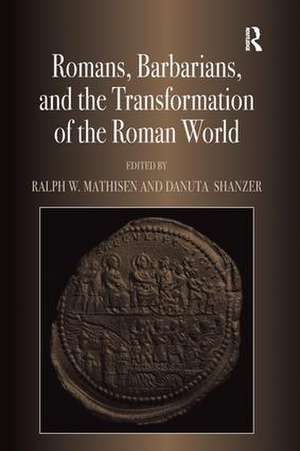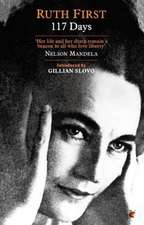Romans, Barbarians, and the Transformation of the Roman World: Cultural Interaction and the Creation of Identity in Late Antiquity
Editat de Ralph W. Mathisen, Danuta Shanzeren Limba Engleză Paperback – 9 sep 2016
| Toate formatele și edițiile | Preț | Express |
|---|---|---|
| Paperback (1) | 326.27 lei 6-8 săpt. | |
| Taylor & Francis – 9 sep 2016 | 326.27 lei 6-8 săpt. | |
| Hardback (1) | 827.64 lei 6-8 săpt. | |
| Taylor & Francis – 28 mar 2011 | 827.64 lei 6-8 săpt. |
Preț: 326.27 lei
Preț vechi: 418.11 lei
-22% Nou
Puncte Express: 489
Preț estimativ în valută:
62.43€ • 65.37$ • 51.78£
62.43€ • 65.37$ • 51.78£
Carte tipărită la comandă
Livrare economică 10-24 aprilie
Preluare comenzi: 021 569.72.76
Specificații
ISBN-13: 9781138270558
ISBN-10: 1138270555
Pagini: 398
Dimensiuni: 156 x 234 x 31 mm
Greutate: 0.57 kg
Ediția:1
Editura: Taylor & Francis
Colecția Routledge
Locul publicării:Oxford, United Kingdom
ISBN-10: 1138270555
Pagini: 398
Dimensiuni: 156 x 234 x 31 mm
Greutate: 0.57 kg
Ediția:1
Editura: Taylor & Francis
Colecția Routledge
Locul publicării:Oxford, United Kingdom
Notă biografică
Ralph W Mathisen is Professor of History, University of Illinois at Urbana-Champaign, USA; Danuta R. Shanzer is Ordentliche Universitätsprofessorin für Lateinische Philologie der Spätantike und des Mittelalters, Universität Wien, Austria and Professor Emerita of Classics and Medieval Studies, The University of Illinois at Urbana-Champaign, USA..
Recenzii
'The present volume comprises twenty-five stimulating papers... the framework and its scrupulous edited papers constitute a research program applicable not only to peoples of western Eurasia but also to indigenes and outsiders in other periods.' The Historian '... a book well worth reading. All in all, this volume provides the reader with many different perspectives on barbarian and Roman interaction in late antiquity. Perhaps the most valuable contribution of the book is the recognition of the fact that the transformation of the Roman world took place in a Roman political, cultural and geographical context. Even the role of the barbarians was defined within Roman parameters and was dependent upon cultural traits as well as political and religious issues.' Opuscula 'This book is about ’the creation of [a] late antique polyethnic cultural world, with cultural frontiers between Romans and barbarians that were increasingly permeable in both directions’ (p. 4). It is not the only way to approach this period, but the debate is one with which every scholar working on this period has to engage, and this volume is a significant contribution.' English Historical Review
Cuprins
Introduction; I: Constructing Images of the Impact and Identity of Barbarians; B: Literary Constructions of Barbarian Identity; 1: Catalogues of Barbarians in Late Antiquity 1; 2: Augustine and the Merciful Barbarians 1; 3: Reguli in the Roman Empire, Late Antiquity, and the Early Medieval Germanic Kingdoms; 4: Were the Sasanians Barbarians? Roman Writers on the “Empire of the Persians”; 5: A Roman Image of the “Barbarian” Sasanians 1; B: Political and Religious Interpretations of Barbarian Activities; 6: Banditry or Catastrophe?: History, Archaeology, and Barbarian Raids on Roman Greece 1; 7: John Rufus, Timothy Aelurus, and the Fall of the Western Roman Empire; C: Imperial Manipulation of Perceptions of Barbarians; 8: Imperial Religious Unification Policy and its Divisive Consequences: Diocletian, the Jews, and the Samaritans; 9: Hellenes, Barbarians, and Christians: Religion and Identity Politics in Diocletian's Rome; 10: Barbarians as Spectacle: The Account of an Ancient Embedded Reporter (Symm. Or. 2.10-12); II: Cultural Interaction on the Roman/Barbarian Frontiers; A: Becoming Roman: Movements of People across the Frontier and the Effects of Imperial Policies; 11: The ius colonatus as a Model for the Settlement of Barbarian Prisoners-of-War in the Late Roman Empire?; 12: Spies Like Us: Treason and Identity in the Late Roman Empire; 13: The “Runaway” Avars and Late Antique Diplomacy; B: Becoming Roman: Social and Economic Interchange; 14: Captivity and Romano-Barbarian Interchange; 15: Barbarian Raiders and Barbarian Peasants: Models of Ideological and Economic Integration; C: A New Era of Accommodation; 16: Kush and Rome on the Egyptian Southern Frontier: Where Barbarians Worshipped as Romans and Romans Worshipped as Barbarians 1; 17: Petra and the Saracens: New Evidence from a Recently Discovered Epigram; 18: Elusive Places: A Chorological 1 Approach to Identity and Territory in Scythia Minor (Second–Seventh Centuries); 19: Barbarian Traffic, Demon Oaths, and Christian Scruples (Aug. Epist. 46-47); III: Creating Identity in the Post-Roman World; 20: Visigothic Settlement, Hospitalitas, and Army Payment Reconsidered; 21: Building an Ethnic Identity for a New Gothic and Roman Nobility: Códoba, 615 AD; 22: Vascones and Visigoths: Creation and Transformation of Identity in Northern Spain in Late Antiquity; 23: Identity and Ethnicity during the Era of Migrations and Barbarian Kingdoms in the Light of Archaeology in Gaul 1; 24: Text, Artifact, and Genome: The Disputed Nature of the Anglo-Saxon Migration into Britain; IV: Epilogue: Modern Constructions of Barbarian Identity; 25: Auguste Moutié, Pioneer of Merovingian Archaeology, and the Spurlock Merovingian Collection at the University of Illinois
Descriere
One of the most significant transformations of the Roman world between the fourth and seventh centuries C.E. was the integration and impact of barbarian peoples into the social, cultural, religious and political Mediterranean world. This was the theme of the 2005 Shifting Frontiers in Late Antiquity Conference at the University of Illinois at Urbana-Champaign. The selection of conferences papers published here remind us that the transformation of the Roman world took place in a Roman context and that Romanitas always was the touchstone against which social, intellectual, and political developments were measured.





